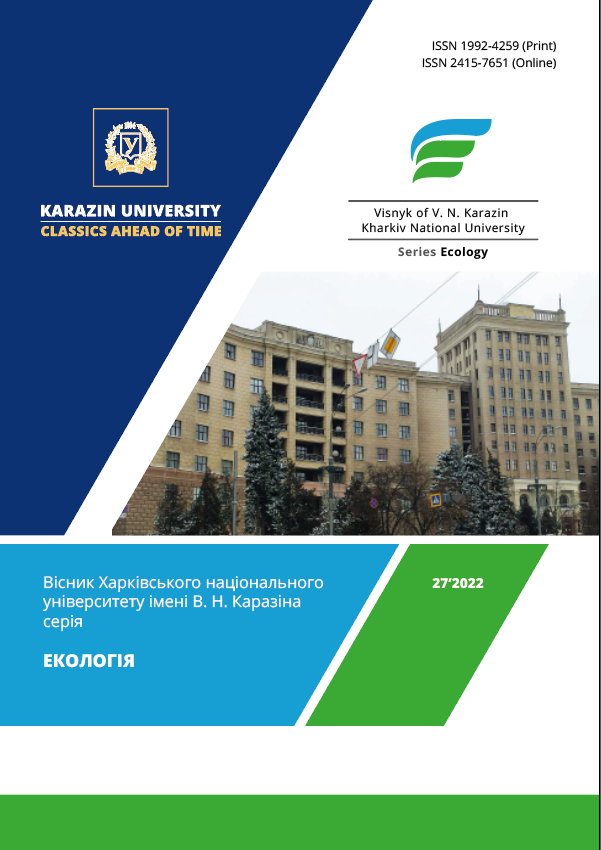Post-pyrogenic transformation of biogeochemical properties of grey forest soils under technological load
Abstract
Purpose. Detection of post-pyrogenic transformation of biogeochemical properties of soils in pine forests of the Kharkiv region under technogenic loading.
Methods. Determination of the pH of the water extract by the potentiometric method, the content of humus and gross nitrogen according to the Tyurin method, the granulometric composition according to Kachynskyi, the mobile forms of phosphorus and potassium according to Machigin. The content of mobile forms of heavy metals was determined by the atomic absorption method.
Results. There is a certain dependence of the post-pyrogenic transformation on the age of fire impact on the soil. Relatively recent consequences of a fire of medium intensity on the soil were marked by a clear reaction of the complex of their properties. Physical-chemical properties of soils in the post-fire period deteriorate due to a significant decrease in the amount of nutrients in the soil: humus burns, nitrate nitrogen content decreases. The acid-alkaline reaction according to the pH index in the soils affected by fires shifts to neutral, which should be explained by the saturation of the absorbing complex of soils with alkaline earth elements. Forest lowland fires significantly transform the morphological appearance of the upper part of the soil profile. Under the influence of fires, there are changes in pH, the content of exchangeable cations, gross and mobile forms of nitrogen, etc. The behavior and content of heavy metals in the forest floor is determined, in addition to the effect of fire and the geochemical state of the region, the speed of water migration and biological absorption, and the topography of the area. The concentration of heavy metals in the surface horizons of the soils of pine forests increases several times and exceeds the background concentrations as a result of the mineralization of the forest floor and grassy vegetation from combustion and subsequent migration of chemical elements.
Conclusions. As a result, the surface horizons of soils change, in particular, a new pyrogenic horizon is formed, which differs in a certain way from natural analogues. Fires, on the one hand, improve the conditions for seed penetration into the soil, but worsen the conditions for the germination, growth and development of coniferous tree species. The concentration of heavy metals in the surface horizons of pine forest soils is an ecological hazard. Further research on the transformation of soil properties under the influence of pyrogenic factors is of significant theoretical and practical importance in the development of scientific approaches to the restoration of ecosystems in the post-fire stage of development.
Downloads
References
Buts, Y. (2012). Pyrogenic relaxation of geosystems. Man and environment. Issues of neoecology, (1-2), 71–76 (in Ukraine)
Buts, Y. (2018). Consequences of the effect of the pyrogenic factor on the biogeochemical properties of ecogeosystems under technogenic load conditions. Scientific bulletin of construction, 93(3),109–116. https://doi.org/10.29295/2311‒7257‒2018‒93‒3‒115‒122 (in Ukraine)
Buts, Y. (2020). The influence of anthropogenic factors on the occurrence of emergency situations of a pyrogenic nature in ecosystems. Scientific bulletin of construction, 102(4), 223–231 (in Ukraine)
Buts, Yu.V., Krainiuk, O.V., Nekos, A.N., & Barbashin, V.V. (2020). Pyrogenic influence on conifer stands in conditions of technogenic and ecological stress. Visnyk of V. N. Karazin Kharkiv National University, series “Ecology”, 22. 65–74. https://doi.org/10.26565/1992-4259-2020-22-06 (in Ukraine)
Hutsulyak, V.M. (1994). Geochemistry of the landscape. (in Ukraine)
Krasnoshchekov, Yu.N. (2014). The effect of the pyrogenic factor on the serohumus soils of pine forests in the Central Ecological Zone of the Baikal Natural Territory. Siberian Forest Journal, 2. 43–52 (in Russian)
Methodical instructions for the determination of heavy metals in agricultural soils and plant production (1989). 62 (in Russian)
Shakhmatova, E.Yu. (2015). Pyrogenicity is the response of soils of dry pine forests to the impact of fires. International Journal of Applied and Fundamental Research, 5, 260–264 (in Russian)
Asotskyi, V., Buts, Y., Kraynyuk, O., Ponomarenko, R. (2018). Post-pyrogenic changes in the properties of grey forest podzolic soils of ecogeosystems of pine forests under conditions of anthropogenic loading. Journ. Geol. Geograph. Geoecology, 27(2), 175-183 https://doi.org/10.15421//111843
Buts, Y., Asotskyi, V., Kraynyuk, O., & Ponomarenko, R. (2018). Influence of technogenic loading of pyrogenic origin on the geochemical migration of heavy metals. Journ.Geol.Geograph.Geoecology, 27(1). 43–50. https://doi.org/10.15421/111829
Buts, Y. Features of geochemical migration of chemical elements after technogenic loading of pyrogenic nature (2018). Journal of Engineering Sciences, 5(2), H1–H4 . https://doi.org/10.21272/jes.2018.5(2).h1
Buts, Y., Asotskyi, V., Kraynyuk, O., Ponomarenko, R., & Kovalev, P. (2019). Dynamics of migration property of some heavy metals in soils in Kharkiv region under the influence of the pyrogenic factor Journ. Geol. Geograph. Geoecology, 28(3), 409–416. https://doi.org/10.15421/111938
Doerr, S., & Cerda, A. (2005). Fire effect son soil system functioning: new in sight sand future challenges. International Journal of Wild land Fire, 14(4), 339–342. https://doi.org/10.1071/WF05094
Copyright (c) 2022 Buts Y. V., Krainiuk O. V., Lotsman P. I., Senchykhin Y. M.

This work is licensed under a Creative Commons Attribution 4.0 International License.
Authors who publish with this journal agree to the following terms:
- Authors retain copyright and grant the journal right of first publication of this work under the terms of a license Creative Commons Attribution License 4.0 International (CC BY 4.0).
- Authors are able to enter into separate, additional contractual arrangements for the non-exclusive distribution of the journal's published version of the work (e.g., post it to an institutional repository or publish it in a book), with an acknowledgement of its initial publication in this journal.
- Authors are permitted and encouraged to post their work online (e.g., in institutional repositories or on their website) prior to and during the submission process, as it can lead to productive exchanges, as well as earlier and greater citation of published work.





